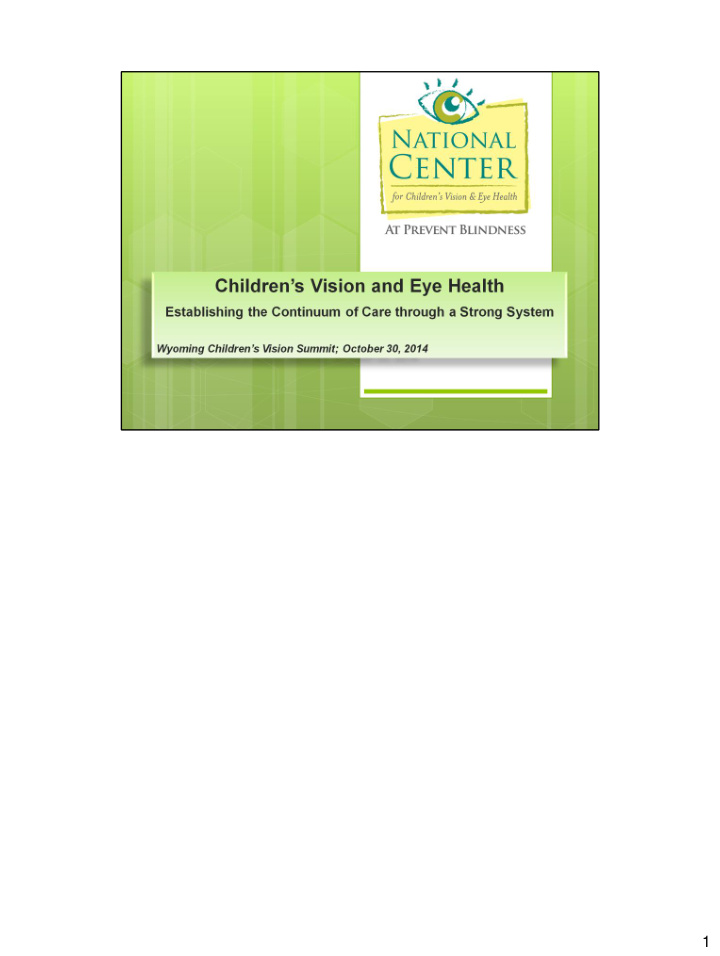



1
2
Presenter : While most of us are trying to do our best when it comes to children’s health, research and available evidence shows us that there are still gaps when it comes to children’s vision screening and accessing eye care. If left unaddressed, these gaps in care can result in a significant impact on quality of life. [Presenter, review bullet-pointed information from the slide] Sources: 1. US Department of Health and Human Services. Healthy People 2020. Objective Retained As Is From Healthy People 2010. V HP2020 – 1: Increase the proportion of preschool children aged 5 years and under who receive vision screening. Access verified Jan 13th, 2010: http://www.healthypeople.gov/hp2020/Objectives/TopicAreas.aspx 2. The Multi-ethnic Pediatric Eye Disease Study. Prevalence of amblyopia and strabismus in African American and Hispanic children ages 6 to 72 Months. Ophthalmology. 2008 Jul; 115(7):1229-1236. 3. Friedman DS, Repka MX, Katz J, Giordano L, Ibironke J, Hawse P, Tielsch JM. Prevalence of amblyopia and strabismus in white and African American children aged 6 through 71 months the Baltimore Pediatric Eye Disease Study. Ophthalmology. 2009 Nov; 116(11):2128-34.e1-2. Epub 2009 Sep 16. 4. Wallace DK et al. Treatment of Bilateral Refractive Amblyopia in Children 3 <10 Years Old. Am J Ophthalmol. 2007 October; 144 (4): 487-496. 5. Wen G, McKean-Cowdin R, Varma R, Tarczy-Hornoch K, Cotter SA, Borchert M, Azen S; Multi-ethnic Pediatric Eye Disease Study Group. General Health-Related Quality of Life in Preschool Children with Strabismus or Amblyopia. Ophthalmology. 2010 Sep 28. [Epub ahead of print] 6. Uretmen O, Egrilmez S, Kose S, Pamukcu K, Akkin C, Palamar M (2003) Negative social bias against children with strabismus. Acta Ophthalmol Scand 81:138 – 142. 3
4
5
Presenter: It is important that you leave today knowing that there are more serious conditions exist that must be treated when a child is young to prevent the development of amblyopia ( pronounced “ àmbli ṓpee ə”) or more commonly referred to as “lazy eye.” 6
Sources: 1The Multi-ethnic Pediatric Eye Disease Study. Prevalence of amblyopia and strabismus in African American and Hispanic children ages 6 to 72 Months. Ophthalmology. 2008 Jul; 115(7):1229-1236. 2Friedman DS, Repka MX, Katz J, Giordano L, Ibironke J, Hawse P, Tielsch JM. Prevalence of amblyopia and strabismus in white and African American children aged 6 through 71 months the Baltimore Pediatric Eye Disease Study. Ophthalmology. 2009 Nov; 116(11):2128-34.e1-2. Epub 2009 Sep 16.) 7
8
Based on data from 2011-2012 NSCH 9
Because we know it is important, we perform vision screenings in a LOT of places. Head Start/Early Head Start Well-child visits Public health clinics Home visiting programs Preschool programs Community outreach programs Need to screen in multiple locations because there is no one consistent location that children this age group are found- unlike newborn hearing 10
screenings conducted in the hospital nursery setting. 10
11
This slide shows a map of vision testing rates among 4-5 year olds who were tested at a pediatrician or other general doctor’s office by DHHS regions. Region label boxes that are marked in yellow were significantly above or below the US average. To summarize, 4-5 YO children in the Great Lakes, Midwest, and South- Central regions had lower rates of being tested in a pediatrician or other general doctor’s office. In contrast, 4 -5 YO children in the Northeast, New York and New Jersey, and the Mid-Atlantic regions had higher testing rates in a pediatrician or other general doctor’s office. 12 12
13
Uniform planning= approach to VS established among multiple stakeholders for children’s vision Surveillance= population penetration; resource allocation; program performance Coordination and collaboration= program approach and data sharing among stakeholders Screening infrastructure= where does the state vision health program live? What are the responsibilities of that program and others? Training= consistency in screening execution and certification expectations Technical advisory processes= provide assistance to screening programs and also support the state Vision Health program staff Laws/Policies= Shifts may be required to meet the needs of the vision health system, drive behavior, and create accountability- ie) State Medicaid reimbursement for instrument-based vision screen Public/Professional education/awareness= engage all of the stakeholders by making them aware of the resources available, vision health expectations, and give them driven actions to take. Sustained funding= Needed for all stakeholders in the system not just the state vision health program 14
15
16
17
18
Will appear in the January 2015 issue of OVS and appear online via ePub ahead of print before that time. They are going to be Open access articles. 19
20
21
22
23
24
25
26
27
28
Note: Provide reminder that questions should be broad in scope- if anyone has questions specific to their situation we will remain in the room afterwards to discuss those questions. 29
Recommend
More recommend